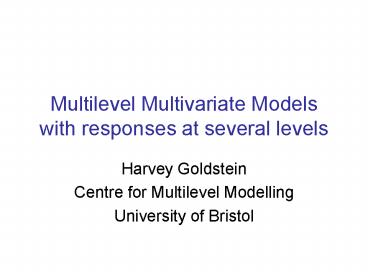Multilevel Multivariate Models with responses at several levels PowerPoint PPT Presentation
1 / 12
Title: Multilevel Multivariate Models with responses at several levels
1
Multilevel Multivariate Models with responses at
several levels
- Harvey Goldstein
- Centre for Multilevel Modelling
- University of Bristol
2
Some examples of Multiple Response Level (MRL)
models
- A level 2 explanatory variable correlated with
level 2 random effects add second equation with
variable as response to avoid bias (
identifiability constraints) - A growth curve model with repeated measures level
1 adult height level 2 used for prediction
system (Goldstein, 2003). - Multiple imputation for missing data with
variables at several levels all variables
treated as responses.
3
Linear growth curve model
See Henderson et al, 2002 for related example
with survival data
4
Imputation for missing data
- Multiple (random) imputation for multilevel data
treats all variables as responses, then - Multivariate multilevel model with intercepts (or
additional predictors) - Random sampling of p sets of residuals to form
p complete data sets (via MCMC) - P models fitted and combined
- See www.missingdata.org.uk
5
Two issues
- Response variables for imputation are at several
levels hence MRL models - Responses are not all Normal need to handle
ordered and unordered categorical variables - Replace these variables with a set of
multivariate (latent) Normal variates - Fit multivariate Normal response model
- Randomly impute missing data on Normal scale
- Convert imputed values to corresponding
categories on original scales - Fit original complete data model etc.
6
Latent Normal variables1. Ordered categories
- Suppose we have a p-category response, numbered
1,.p. Consider the probit link proportional
odds model
are thresholds reduces to familiar
binary Probit model when p2
Note that we condition on other (adjusted)
responses in model
7
MCMC steps
- For use a MH step with suitable (Normal)
proposal (more efficient than Albert Chibbs
Gibbs procedure) - For a category p response we sample from the
standard Normal distribution - Leaves us to sample from multilevel multivariate
Normal response model (see below) - .
8
Multicategory Responses
- The multiple indicant model (Aitchison
Bennett, 1970) - consider the multinomial vector with p
categories, where the response, y is (0,1) in
each category. - We select a sample from v distribution and if
maximum corresponds to category with a 1 then
accept, otherwise choose another sample.
9
Multiple Normal responses at different levels
MCMC steps
A 2-level model can be written (i indexes
response, j,k levels) The level 2 residuals
from level 2 response are obtained by
subtraction The level 2 residuals for level 1
responses are conditioned on level 2 residuals
for level 2 responses.
10
are multivariate Normal with structured
covariance matrix (e.g. zero correlations for
p-category variables). Sampled using MH element
by element. Level 2 random effects and fixed
effects are sampled using Gibbs as in standard
MVN case.
11
Missing data data example
- Class size model with missing data for all
variables except class size total sample size
6611. Listwise deletion of missing data yields
4786 cases. 10 imputations every 500 iterations,
2000 burnin.
Coeff Listwise delete Normal Model Latent Normal model
Intercept 0.047 (0.043) -0.010 (0.050) -0.010 (0.045)
Prior Maths 0.612 (0.011) 0.623 (0.011) 0.622 (0.011)
Girl -0.042 (0.020) -0.041 (0.019) -0.037 (0.019)
FSM -0.144 (0.030) -0.140 (0.029) -0.136 (0.032)
Class size -0.008 (0.008) -0.014 (0.009) -0.012 (0.008)
12
References
- Aitchison, J. and Bennett, J. A. (1970).
Polychotomous quantal response by maximum
indicant. Biometrika 57 253-262. - Albert, J. H. and Chibb, S. (1993). Bayesian
analysis of binary and polychotomous response
data. Journal of the American Statistical
Association. 88 669-679 - Blatchford, P., Goldstein, H., Martin, C. and
Browne, W. (2002). A study of class size effects
in English school reception year classes. British
Educational Research Journal 28 169-185.
(download from www.mlwin.com/hgpersonal) - Goldstein, H. (2003). Multilevel Statistical
Models. Third edition. London, Edward Arnold

